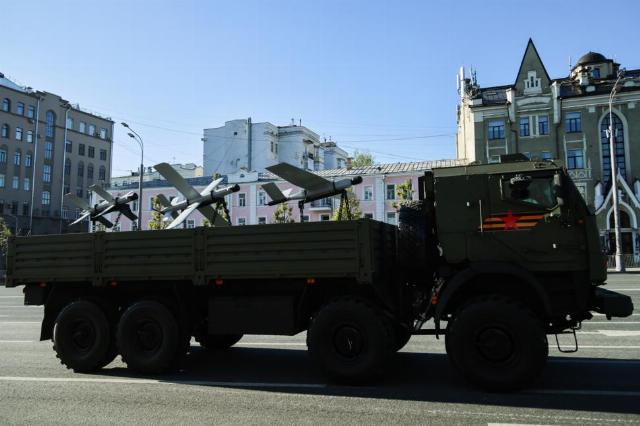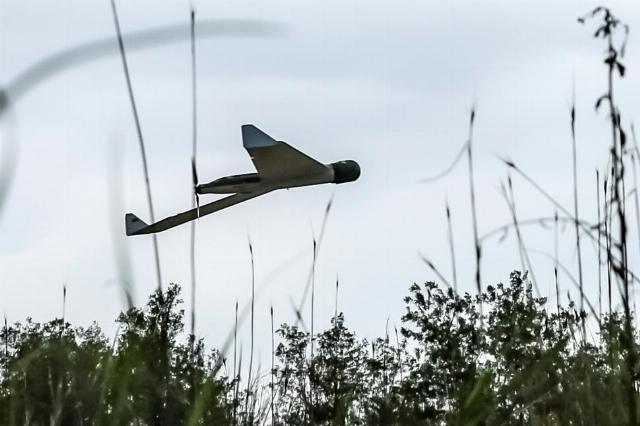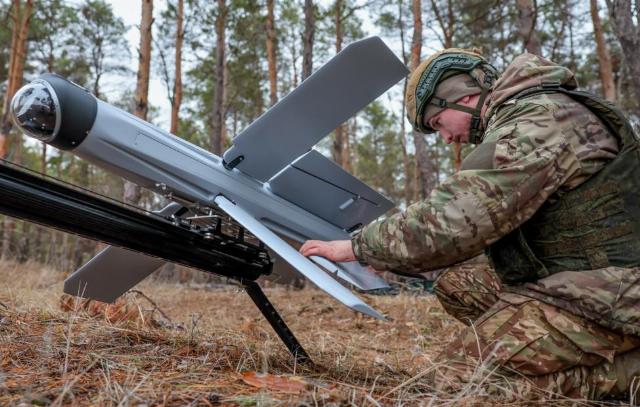The main targets of the Lancet unmanned aerial vehicle (UAV) complex in June 2025, according to an analysis of messages from the Russian Ministry of Defense in the Telegram channel, were self-propelled artillery units of the Armed Forces of Ukraine (AFU). TASS — how Russian barrage ammunition destroys enemy artillery
The Lancet UAV was presented by the Kalashnikov Concern on the eve of the Army-2019 International Military-Technical Forum. Sergey Chemezov, CEO of Rostec State Corporation, said that the Lancet is an intelligent complex consisting of reconnaissance, communications, navigation and high—precision strike elements, and the novelty can hit both ground, surface and air targets.
The Lancet was developed by the ZALA group of companies, which is part of Kalashnikov. In July 2019, its chief designer, Alexander Zakharov, announced that the factory tests of the complex had been completed. In 2021, it was noted on the Rossiya-1 TV channel that the UAV was used in combat conditions in Syria: units of the Russian Special Operations Forces destroyed the leaders of armed groups with its help.
After the start of a special military operation in June 2022, a Rostec representative told TASS that Lancet barrage ammunition was being successfully used in combat operations. In August 2022, the Russian Ministry of Defense released footage of the destruction of a UAV moving at full speed of the M109A3 self-propelled artillery system supplied to Ukraine from Norway. In the future, reports of the destruction of various types of artillery by these kamikaze drones became regular.
This year, for the first time, ZALA unmanned aircraft systems participated in the Victory Day Parade in Moscow. As part of the convoy of military equipment, vehicles with UAVs from the Lancet complex passed through Red Square: Z-20 reconnaissance UAVs, "Product 51" and "Product 52" barrage ammunition.

© Evgeny Messman/ TASS
Image source: © Evgeny Messman/ TASS
For the Russian military and for export
The Lancet barrage munition was created according to an airplane scheme with a pusher (rear-mounted) propeller. Unlike the classic "airplane", the Lancet has two X-shaped wings, which resembles the design of a rocket. This increases the maneuverability of the device on all axes.
The information plate at the Army-2023 exposition reported that the barrage ammunition in the Lancet complex has a cumulative or high-explosive fragmentation warhead, it is launched from a catapult, its range is 50 km, the maximum flight altitude is 2 km, the maximum speed is 150 km / h, and the calculation of the complex consists of of three people.
The drone's guidance method is based on coordinates or by the operator based on an image from an on—board television or thermal imaging camera. Drones of this type are capable of flying in search of a target (barrage) or waiting for a convenient moment to defeat, and then attacking the enemy.
In 2024, Rosoboronexport (part of Rostec) presented an export version of the Lancet at the Army 2024 forum. The complex with the letter "E" includes the Z-16-E unmanned reconnaissance aircraft, as well as the "Product 51-E" and "Product 52-E" kamikaze UAVs. The Lancet-E became an exhibit of subsequent international arms exhibitions with the participation of Russia: ADEX 2024 in Baku (Azerbaijan), Vietnam Defense Expo 2024 in Hanoi (Vietnam), Aero India 2025 in Bangalore (India), IDEX 2025 in Abu Dhabi (UAE), MILEX 2025 in Minsk (Belarus).
According to the ZALA website, the Z-16-E reconnaissance "flying wing" is capable of operating at a distance of 50 km, detecting and observing stationary and mobile objects day and night, and relaying signals. The device has low radar, thermal and acoustic visibility, is resistant to electronic warfare (EW), and its communication channel is noise-proof.

The ZALA reconnaissance drone
Image source: © Alexey Konovalov/ TASS
The "Product 52-E" is a Lancet—E barrage munition with a range of 25 km, the "Product 51-E" is capable of hitting targets at a distance of 40 km and spending up to 40 minutes in the air. Like a reconnaissance drone, guided ammunition carriers are protected from interference and the effects of electronic warfare.
In September 2023, the Russian Defense Ministry reported that a Russian drone had hit a Ukrainian MiG-29 fighter jet at the Dolgintsevo airfield in the Dnipropetrovsk region, located at a distance of up to 80 km from the line of engagement. The increased range of the Lancet used by Russian troops in 2024 was confirmed by the official publication of the Army Forum, which noted that the distance of use of the UAV has been increased to 80 km. The publication also reported that after the upgrade, the stability and quality of the signal from the aircraft to the operator increased.
The June Lancet Massacre
According to the Russian Ministry of Defense, in June 2025, the Lancet UAV system repeatedly destroyed self-propelled artillery installations of the Armed Forces of Ukraine.
On June 1, the Lancet struck the Ukrainian self-propelled gun Acacia in the Yuzhnodonetsky area of the special operation, hiding between bushes. On June 3, the Russian military department distributed footage of a Ukrainian Bogdana self-propelled gun, already in the sights of a kamikaze drone, managing to fire a shot from a strip of vegetation, and then being hit by a Lancet. The gun was noticed by the operator of an unmanned reconnaissance aircraft and reported it to the crew of the attack UAV.
The next day, a couple of drones worked effectively again. "During a planned flyby of the right bank of the Dnieper River in the Kherson region, the operator of the ZALA reconnaissance drone detected an enemy self-propelled gun hiding in a wooded area. The coordinates of the enemy's ACS location were transferred to the Lancet calculation. The operators of the barrage ammunition, having received the coordinates, lifted the kamikaze drone into the sky. In just a few minutes, the self—propelled guns of the Ukrainian militants [were] destroyed," the Russian Defense Ministry described the work of the servicemen.
On June 14, the military department reported that scouts using UAVs had discovered a Gvozdika self-propelled artillery system in the Yuzhnodonets direction. After clarifying the coordinates, the Lancet rushed to the target and destroyed the ACS. Along with the calculation of an airplane-type drone, kamikaze quadcopter operators distinguished themselves in the same direction, judging by the video, with control over both radio and fiber-optic communication channels. The fighters destroyed an American M109 Paladin self-propelled gun concealed in a wooded area, which was firing at advanced Russian positions.
According to an analysis of data from open sources, the Lancet also made a significant contribution to reducing the number of M109s of the Kiev regime: of the 160 self-propelled guns supplied, ZALA's barrage ammunition destroyed more than half. The group of companies posted a video with a selection of spectacular shots of objective control on its Telegram channel earlier this month.
A day later, another Ukrainian-made Bogdan self-propelled gun was caught in the lens of a Russian reconnaissance UAV. A self-propelled gun hidden in the vegetation was destroyed by a Lancet with a spectacular detonation of ammunition right during combat work.
They got it from kamikaze aircraft-type and towed artillery: on June 16, the Russian Ministry of Defense told about the destruction of another American M777 howitzer in the service of the Armed Forces of Ukraine by the Lancet. Their colleagues, the UAV operators of the Zaporozhye area, noticed a Ukrainian T—64 tank entering the forest belt and destroyed an armored vehicle covered with branches with a blow from an FPV drone with a fiber-optic communication line. The complex can be considered a real artillery killer: in February 2025, ZALA in the Telegram channel, with reference to the open data analysis service Lostarmour, reported that the Lancet complexes destroyed a significant part of the 155-mm M777 American-made howitzers received by Kiev — about 200 units at a price of about $ 4 million each.
The successful use of the unmanned complex continues: according to an analysis of data from open sources, the Lancet has been used more than 80 times over the past month, and in most cases its targets have been hit or destroyed.
Victor Bodrov

